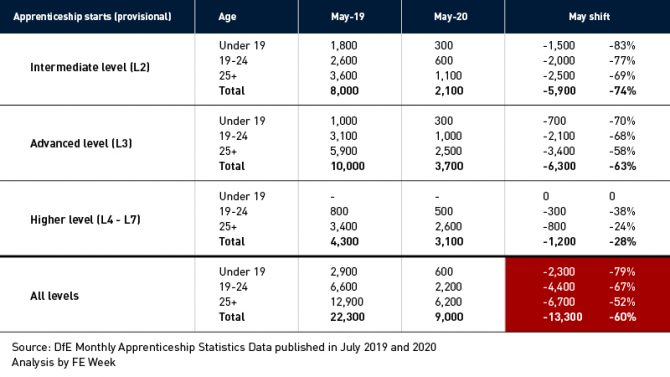Apprenticeship starts for the month of May 2020 fell 60 per cent on the previous year, figures published this morning show.
According to Department for Education data, there were 22,300 starts in May 2019 but this dropped to 9,000 12 months later, which would have been caused by the Covid-19 lockdown.
Young people appear to be the hardest hit as starts for those aged 16 to 18 plunged by 79 per cent, from 2,900 to 600.
Starts on level 2 apprenticeships have also fallen more than any other level – from 8,000 in May 2019 to 2,100 (74 per cent) in May 2020.

Today’s data also shows that starts have continued to fall by around half since lockdown started in March.
There have been 34,690 apprenticeship starts reported to date between March 23 and June 30, 2020, fewer than the 72,800 reported for this period at this point last year, a decrease of 52.3 per cent.
The DfE’s statisticians note that final data will not become available until later in the year, therefore “at this point it is unclear what the true number of starts in the affected period was or if the level of reporting at this point in the year has been affected by the lockdown”.
Latest apprenticeship vacancy data, from the government’s Find An Apprenticeship website, has been released and shows a considerable drop.
Vacancies in April, May and June 2020 – the three full months for which data are available since the coronavirus restrictions were implemented – were 2,120, 1,850 and 4,030, which compares to 10,900, 13,030 and 12,100 in April, May and June 2019 respectively.
The DfE has also, for the first time, published data about its ‘Skills Toolkit’ – a website which directs people to existing free courses.
An estimate of “at least 136,000 registrations” were recorded on the courses that featured on the toolkit since it was launched in late April 2020.
The DfE said this is a “provisional” estimate as there “may be a data lag in reporting”. The department also doesn’t hold comparible data for registrations on the courses pre-Covid, so it is unclear whether their popularity has increased or fallen.
Association of Employment and Learning Providers managing director Jane Hickie said today’s starts numbers, including the “big drop” in advertised vacancies, show why the government “made a serious error in deciding that its Covid provider relief scheme should not cover the large majority of apprenticeship provision“.
“Providers are now having to take very difficult decisions about reducing capacity despite the measures announced by the chancellor in his summer statement,” she added.
“The government’s Plan for Jobs will be an acid test for getting the apprenticeship programme back on its feet. The key question is whether the new employer incentives will be large enough to really make a difference.”
Responding to today’s data, apprenticeships and skills minister Gillian Keegan said: “Apprenticeships are a fantastic way to get ahead in a wide range of exciting industries and will also play a vital role in delivering the skills our economy needs to grow after coronavirus.
“To help create more high quality apprenticeship opportunities we are providing £2,000 to employers for each new apprentice they hire aged under 25 and £1,500 for each new apprentice they hire aged 25 and over.
“We are also investing £111 million this year to triple the number of work placements available across England to help more young people gain the skills, experience and confidence they need to enter the world of work.”


![iStock-513065606-[Converted] | FE Week](https://feweek.co.uk/wp-content/uploads/2018/08/iStock-513065606-Converted-1000x525.png)






Probably worth referencing the EFSA’s caveats on using this data to compare year on year.
Everything appears correctly reported above but…. the final May starts out-turn for 18/19 was 24,747. The figure quoted above is 22,300 which is the starts figure for May but as it stood in July (not year end).
Whilst it might seem reasonable to compare numbers from the same point in different years, COVID wasn’t with us in July 2019 and volatility levels within the data are different as a result, so it is not really comparing like for like. The further you then drill down by level, age etc the volatility increases.
As an example, the May 2020 starts figure reported in June was 10,721, but in July the May 2020 starts figure is now 8,951 (-16.5% in a month). The further back you go the variance diminishes, but even for February data there is +5.2% shift in starts since last months data release.